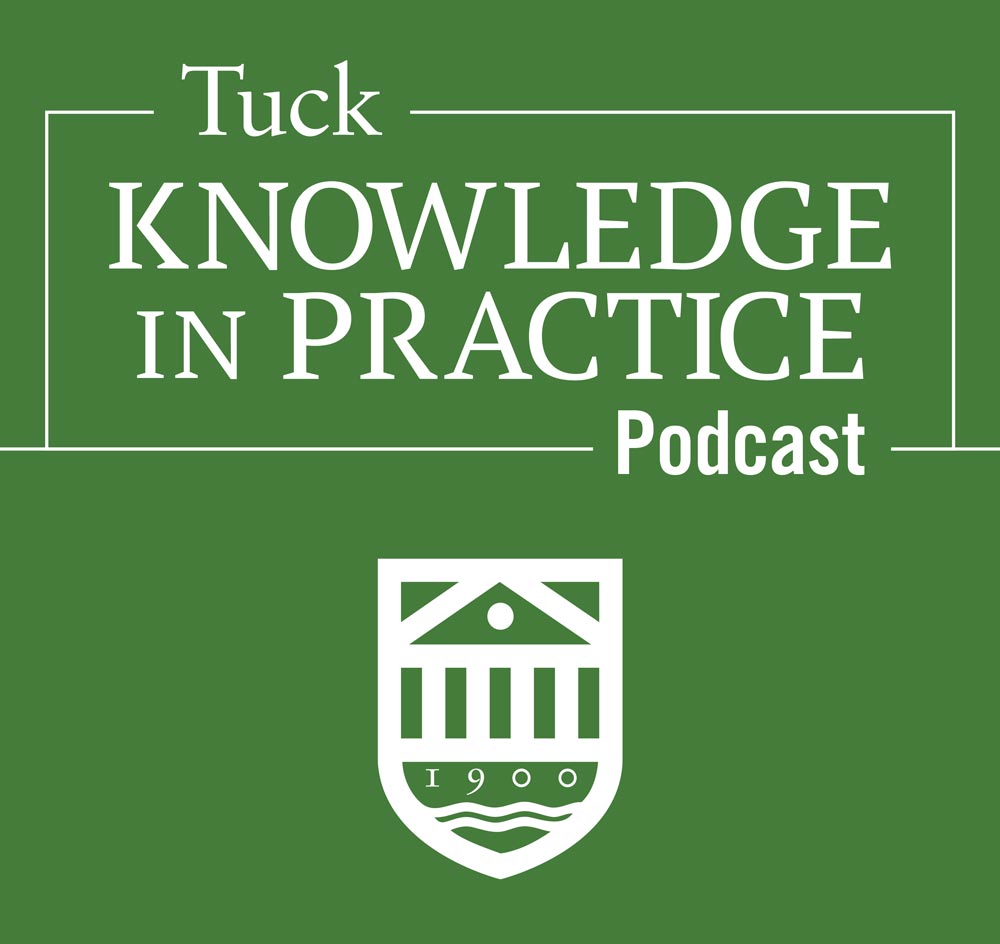Tuck Knowledge in Practice Podcast: How the Tech Giants Became Modern Conglomerates
Tuck professor Gordon Phillips explains how today’s tech giants are redefining the classic conglomerate model by expanding through innovation and increased operational scope.
If the 20th century business landscape was populated by behemoth corporations like GE, Berkshire Hathaway, and Siemens, the 21st century is the era of technology titans such as Apple, Amazon, and Tesla. But these huge firms are separated by more than the border line of Y2K.
As Tuck professor Gordon Phillips explains in this episode of the Knowledge in Practice podcast, the modern tech giants achieved their status not by gobbling up firms in various industries and putting them under one big roof; they did it by developing technologies that have applications in numerous, related sectors. In a new paper, Phillips identifies these companies as “21st century firms” and shows that they have used R&D to increase the scope of their operations by 60 percent between 1989 and 2017. This has resulted in increased valuations, and a significant boost to the markets overall.
“One of our major findings is that valuations go up as scope goes up,” Phillips says. “This is the opposite of the old line conglomerate literature. What’s interesting is that on a per-dollar-of-sales basis, the market is liking these increases in scope.”
Research paper discussed: Scope, Scale and Concentration: The 21st Century Firm
Listen Now
Our Guest

Transcript
[This text may not be in its final form and may be updated or revised in the future. Accuracy and availability may vary. The authoritative record of the Tuck Knowledge in Practice Podcast is the audio record.]
Media Clips: Some like it hot hot hot. We sure do. Hey, S&P 500 is coming off of its third consecutive day of closing at an all-time high.
Media Clips: That's right. The Dow Jones also set its record at Monday's close. And the historic gains are being driven by just a handful of massive tech stocks, the so-called Magnificent Seven.
Media Clips: The seven stocks reminded people of the fabulous movie, where seven of the most badass gunfighters went to Mexico to save a village from some cynical, vicious bandits.
Media Clips: The Max Seven is the way to go. It's going strong. It's made a very strong comeback. You've got to stay invested in the Max seven.
[Podcast introduction and music]
Kirk Kardashian: Hey, this is Kirk Kardashian, and you're listening to Knowledge in Practice, a podcast from the Tuck School of Business at Dartmouth. In this podcast, we talk with Tuck professors about their research and teaching, and the story behind their curiosity. Today on the podcast, Tuck Professor Gordon Phillips is going to introduce us to a new type of company he has documented in recent research. He calls them 21st-century firms, and they include a group of companies known as the Magnificent Seven. We're talking about firms like Apple, Amazon, Alphabet, Meta Platforms, and even Tesla. What makes these firms special, and why does Gordon give them their own new category? Listen on to find out. Gordon Phillips is the Lawrence F Whittemore Professor of Business Administration and a professor of finance. He teaches the second-year course Venture Capital and Private Equity. He is a faculty advisor at the Center for Private Equity and Venture Capital, where he was the faculty director for five years, reorganizing and helping to expand the previously named Center for Private Equity. Gordon is also a research associate at the National Bureau of Economic Research and a visiting research professor at Tsinghua University in Beijing. His areas of research include corporate finance and how financial decisions impact firms' strategic decisions and contracting in financial markets. His work in corporate finance includes studies of private equity issuance, capital structure, chapter 11 bankruptcy, and how leveraged buyouts and other forms of high debt influence a firm's and rival's investment decisions.
Kirk: Now, this is a really interesting paper, I think, because it documents a new type of firm that hasn't really been discussed before, which you call the 21st-century firm. Introduce us to this 21st-century firm and tell us its defining characteristics.
Gordon Phillips: Well, thank you, Kirk. It's a pleasure to talk with you. The 21st-century firm just comes from our observation, which I think is pretty clear as well. The scope of firms, the nature of what they do, and when they become larger have changed quite substantially in the 21st century. We see these very big, large mega firms that have grown through the use of technology and the use of related assets to expand in multiple industries. These firms are producing in multiple related industries, using technology and growing to a very big size, such that many antitrust regulators and others are worried about the size of firms. Yet, we see that consumer prices have increased, and consumers have more products to choose from, as these firms are offering a broader scope of products.
Kirk: So, you're talking about large firms that have grown through technology. So, in your paper, you contrast these 21st-century firms with traditional conglomerates. These are firms like GE, which operates in aviation, health care, renewable energy, and financial services. Another example is Samsung, which does electronics, shipbuilding, construction, and biotech. How do these 21st-century firms differ from those traditional conglomerates? And can you give us some examples of a 21st-century firm that we might recognize?
Gordon: Another conglomerate, not to expand your list, would be Berkshire Hathaway. Berkshire Hathaway and even GE were operating across different industries, some of which were partially related, but others were not. They were basically sharing, perhaps management, and then financial resources across different industries. Berkshire Hathaway, for example, is very famous for doing this. They act more like a diversified conglomerate, but they have a financial operating holding company, and they buy companies and transfer resources from one division to another. GE was a bit more tightly integrated. It has now narrowed its scope because many of these segments are not as related as they thought they were. So, the new firms would be using technology in a way that actually helps them produce new products and new industries. The perfect example is Apple. Apple used to be Apple Computer. Now it's just Apple Inc. We started off using their computers. So, they really started with computers. And then they went ahead and introduced, as we know, the iPhone. The iPhone has been very, very successful. It's kind of like a mini computer, but it's really a totally different market. And then they even have the AirPods for your ears. Again, there's a little teeny bit of technology there. And they have, of course, the App Store, which is the big thing, which provides services where we can download software to use on the iPhone. And they used to have, of course, IMusic, but they kind of discarded that a little bit in favor of streaming, so they keep changing the composition of what they do. The common element is that their products have a much tighter integration across the product lines, across the different products. And we know some of the other big technology companies.
Gordon: Another example, which I think people do realize is probably less tightly related to what they do, is Amazon. Amazon started selling books, as we know, and they sell everything now on their platform. But they also have AWS (Amazon Web Services), right? And that came out of their use of technology. And then they offered this to others as a platform for people to obviously host their apps and run applications. So, AWS has become very large and an important part of their profits and revenue stream. Of course, they bought Whole Foods, they bought a grocery store. We'll see how that turns out. If you go in, though, you can use your Amazon Prime account, and they set up for delivery for Amazon Fresh. So, they're really just starting into a few more segments like that, which would say groceries. How are those related? And they have new stores that are coming out in Seattle. A few of them come out where you walk in, there's no cash register, and it knows who you are from your Amazon account, and then you don't even actually go by the checkout. It knows the products you're picking up, and you walk out with your products. Now, some people find that creepy, other people find it, you know, ‘hey, this is convenient.’ We'll see how it plays out. But it still is an example of a large firm, Amazon, extending what it does to other domains.
Kirk: I think when you talk about Apple and Amazon, those are clearly different from the mainline conglomerates that we're used to because what they're doing is, they're introducing new products that are still pretty closely related to each other, related to the technology that they've developed in one area, and they use that technology to go to another area. So, I want to just contrast that a little bit with what researchers had been talking about with conglomerates. So, conglomerates have been talked about in corporate finance literature for a long time. And you take kind of a different tack. You're sort of discovering this new phenomenon or this new pattern among firms. If you could summarize it, what was the conventional wisdom about conglomerates in the corporate finance literature?
Gordon: Conventional wisdom was that as the capital markets developed, we didn't need a firm to reallocate the money within the firm. So, the reason for the conglomerate firm was to reallocate financial resources, from a cash-rich to a cash-poor division or a firm, and to act as an internal financial market. That was typically the reason given. The U.S. says financial markets have developed. We don't need the firm to do that reallocation; the capital markets can do the reallocation. So, it's got to be something more for why you put two firms together. It can't be just because of access to financial capital. Even management skills have become broader, there's more depth in management. So, you don't need one central CEO to run everything. Now, internationally, we still see the more typical conglomerate. So, in Korea and other countries that don't have as developed capital markets, there may still be a need for a central headquarters to allocate the resources. So, what happened in the U.S. is that those firms fell out of favor. They were just allocating financial resources.
Gordon: GE, as we know, has been busted up into divisions now. And the divisions are doing perfectly fine by themselves. They're specializing, they're bringing in specialized talent to run each one, so you don't have to run it out of a central headquarters, which is more distant from where the firms are doing business. So, these new firms are doing things that are more tightly linked to their main line of business. And you kind of need there to be enough spillover in the product side that they're not in existence to reallocate financial resources. They're in existence because they're providing related products, and they can do that as a bundle at a lower cost to consumers. So, it's more of a typical synergy-based explanation for why they're operating across multiple product areas. And that was kind of our central thought when we started this project. Hey, there's something different going on here. Because even the financial databases did not define Apple as a conglomerate. People kind of look at it and say, it's not really a conglomerate, right? Or have a bundle of products that are quite related to each other.
Kirk: These conglomerates are being busted up in part because of the conglomerate discount. That's what's happening, right?
Gordon: And these old traditional ones, they were selling at a discount in the stock market. If you bust them up into individual units, you could get a higher price. So, they said, well, let's spin them off. Spin off some of the divisions. They can operate on their own. Not the case for Apple. We have a huge premium for Apple, for Amazon, for Google, for Facebook, even, which might be called the new 21st-century firms.
Kirk: Let's get into your paper a little bit. One of the main findings of the paper is that the average firm's scope in related industries has increased roughly 60 percent during your sample period, which is 1989 to 2017. You just mentioned the conglomerate discount, but what other forces do you think in the economy led to this increase in scope?
Gordon: Well, the increased scope is the opposite of the conglomerate discount. We find a 20th-century premium for these firms. The point is, the total firm is selling, as its scope increases, for a premium in the stock market. Stock market values this because they see again offering multiple products consumers like at a lower cost. And that is the central premise of these things. And this is why we thought that even in the databases that we use in financial research, they were not recognizing the increased scope. So, there was no way to even measure how much scope is increased. That was one of the features of the paper. We were able to measure the increase in scope using a large language model. So, we use today's 21st-century techniques to measure how much scope is increased.
Kirk: Tell us a little bit about your methodology. I know you used some pretty high-tech machine learning, right?
Gordon: I've been using this machine learning in other capacities, but this is the one we think is the best. We start with natural language processing. So, we take the text of the firm's 10-K statements, where they define in their business description all of the products they produce. And so, firms have a large incentive to report this truthfully because analysts look at it, and the SEC actually will regulate it. And you can't claim you're making something you're not making. So literally, the impetus part of this project came from looking at Apple's 10-K over the years. It started in 1997, way back when it was just doing computers. So, they just had the computer description, you know, the Mac, that's all they had was the Mac, and you had the Lisa. And then they added more products. They went to online digital services. They went to streaming—the iPhone was revolutionary. In 2007, they introduced the iPhone. And we saw the 10-K had all that information, had the information about the iPhone. And then, as you look forward, it has the information about digital streaming of music. All these products are described in their 10-K, but the database is, even on Wall Street, when they recognize the industry firms belong in, they still have Apple in the computer industry. Just the computer industry. So, you couldn't measure their scope increase by looking at public databases.
Gordon: So public database would have a code for computers. What we've done is we used a Doc2Vec large language model. And in this model, we were able to capture multiple related product lines as they increase. We were measuring the exposure of the firm to multiple product areas. So, first, we measure the product areas using several different methods, and then we would score the firm on all of the product areas so we could pick up the increase in scope for a firm like Apple. We are also able to pick up the increase in scope for a firm like Tesla. You'd say Tesla, that doesn't sound like a conglomerate. It's not a conglomerate firm, right? We wouldn't think of it as one. But they have solar power. They have the Tesla batteries. They have a whole bunch of other things they make under the Tesla umbrella. They're trying to do autonomous driving and some other segments like this. And they're doing all those software segments as well as the car, and not just the car, they have solar panels you can buy for your house. You can buy a storage system of batteries, a battery wall for your house. And so our method would be able to pick up this increase in scope for even a company like Tesla, given the statements they've released over time.
Kirk: That's really interesting. And you've done this sort of method in many other papers, too, right? That you and your research colleague, Gerard Hoberg, have kind of pioneered, right?
Gordon: We started back just measuring the number of products firms are making without trying to think about how to measure scope. And so, then we went ahead and looked at merger synergies when two firms merge. Where is it likely they might produce new products? Again, we weren't measuring the scope of the firm directly. So, this latest project, we're using some of the same techniques, but with a large language model in this case. So, we can then score the firm across these different industry vocabularies that we build with the large language model.
Kirk: So aside from identifying an increase in these firms' scope, in the paper, you also tease out how these firms achieve that scope. What can you tell us about the way the firms increase their scope?
Gordon: Yeah, this is related to the fundamental inputs that the firm is using. The biggest way firms increase their scope is through R&D. R&D is a primary driver of increased scope. They also do acquisitions. They do acquisitions of smaller firms. As we talked about, some things are developed internally, like AWS and Apple. They develop other things, like some of their other purchases that they've done, including Whole Foods, which was purchased. And then Apple, for example, has done many acquisitions. One of the acquisitions was again of a headset company. And then after they bought the headset company, they expanded the product line and introduced the earbuds. So, it was traditional headsets before they bought the basic technology and put some more computerized things into these little, teeny earbuds. And now, for example, they can act as a hearing aid for people. They can use your AirPods as hearing aids. So, they continue to branch into things like that.
Kirk: Another aspect of your paper is the outcomes these 21st-century firms see as their scope goes up. What are the main financial outcomes you observed in your paper?
Gordon: The main financial outcome we've observed is what happens to their valuation over time. So that was kind of given the online research, what happens to it? And the biggest finding there is that valuations go up as your scope goes up. So, this is the opposite of the old-line conglomerate literature. The conglomerate literature was that as the number of segments went up, unrelated things, your valuation went down per dollar of assets. What's interesting on a per-dollar-of-assets basis or per-dollar-of-sales basis is that the market is liking these increases in scope. So, the valuations go up. And that's probably the biggest outcome. Profitability remains relatively flat. You think well, maybe profitability should be going up, but they don't really increase prices. What they do is expand the scope of the firm, but they don't lose profitability. So even though you're bigger, a traditional firm would, as they get bigger, have lower profitability on average. Well, what's happened interestingly for these firms is that they seem to be having profitability with no decreases. The valuations go up because firms are appreciating these new products.
Kirk: In your paper, you identified these new firms. You identified how they go about getting this increased scope, and that increased scope leads to increased valuations. In your mind, what are the main implications of your paper for managers and investors?
Gordon: Well, let's start with investors. Implications are that you have to keep an eye on these companies. If you have some of these companies in your portfolio—most of us do—if you own the S&P 500, you've got these, some people call them the Magnificent Seven. You've got some of these and some other companies as well in your portfolio. Right now, the market loves this, and profits have not decreased and have remained constant. So, there's not yet seen to be a change in the guard, so to speak. But we have to be careful because technology changes all the time. And if you look at cell phones, we know that originally, we had traditional things like Motorola with a flip phone. We had Nokia with phone. We had many other companies with phones. And Apple has come along with Samsung. But Apple has had great success there with its phones. And it's been going since 2007. So that is a long time for technologies to remain dominant. So that is again 17 years, right? The iPhone has been dominant. Will it be dominant ten years from now? I wouldn't bet against Apple, but you've got to keep an eye on how technology evolves. Maybe there's a new technology that comes along, and the iPhone is not going to keep up with it. So, in the end, I think investors should watch out. And even managers—managers have to keep up with technology. Of course, even Apple says, hey, we have high profits now, but we have to keep investing, keep doing R&D. We have to keep up with the latest technology. With the latest iPhone, they introduced AI on the iPhone. Not quite out yet. We'll see what happens. If they're successful, they may extend their market leadership for a longer period.
Kirk: For managers, is there anything to take away from your paper? What do you want to stress?
Gordon: For managers, I'd say the key thing is to make sure when you expand your product lines, make sure they're tightly related to what you're doing. You don't want to be like the old-style conglomerates and do something in a field that's a little bit too far away from what your core competency is, or what skills you're bringing. That's what happened in the past. Managers can always say, ‘Well, it really is related.’ But again, it's you have to be very careful to make sure it's related. How much does it have to be part of the organization? Could it be spun off into a separate company and survive successfully?
Kirk: Gordon Phillips, thank you very much for your time. It's been great to talk to you.
Gordon: Thank you. Thank you.
Kirk: Many thanks to our guest on the podcast, Gordon Phillips. You have been listening to Knowledge and Practice, a podcast from the Tuck School of Business at Dartmouth. Please like and subscribe to the show. And if you enjoyed it, then please write a review as it helps people find the show. This show was recorded by me, Kirk Kardashian. It was produced and sound designed by Tom Whalley. See you next time.
[podcast outro and music]
Kirk: Yo, T-Bone, did you produce this?
Speaker3: Sounds good. Right?



